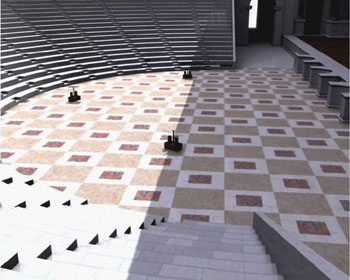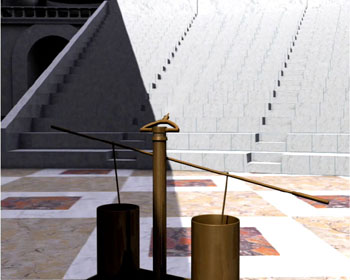- Article by: Publius Memmius Albucius
- From Provincia Gallia webzine: QUIRINUS L. Arminio Ti. Galerio cos. ‡ MMDCCLX a.u.c. June edition.
Professor Philippe Fleury, co-header of "Plan de Rome" project, and Sophie Madeleine, engineer, both from the University of Caen, France, have given this wednesday 6th June 2007 in Caen M.R.S.H, a pretty interesting conference on the 'Mechanical systems in ancient Roman shows'.
This conference has showed how a computer sharp and scientific reconstitution may bring to the understanding of the daily life in the ancient imperial Rome.
Four systems, used in show places, have been presented this 6th June : the velum, the musical organ, the stage curtain and the piston pomp. A remind of the existing textual (wood, stone etc.), iconographic, or archeological sources, was followed by a sheme of every system. Last, the conference tried to test, thanks to the computer reconstitution, the hypothesis made.
The piston pomp, the same one used by the urban vigils to fight the flames, was thus used during the shows. Placed on the ground of the theater orchestra, it allowed the spectators to get a perfumed and refreshing atomizing.
What brings here, for instance, the virtual reconstitution, is to show that three pomps were enough for this task, and that every one of them could just throw its cloud to a limited distance. The experiments made by Pr Fleury’s team have shown that the scope of this splashing covered, in the theater of Pompey, in Rome, the seats where the senators sat. Height of refinement, water was mixed with saffron.
 
Applied to the same theater, the reconstitution of the stage curtain, which rose from a groove which separated the orchestra from the scene stage, has been conducted according the datas recorded in Arles and Lyons, where a 5 meters high curtain seems to be proved. Virtual reconstitution then let us see that, even from the 37 meters high upper seats rank, the curtain perfectly hided the whole stage. On the contrary, from the seats beyond an approximative angle of 60°, right and left from the stage, spectators could see the stage, but only from a certain distance of the curtain. Must then one consider that the curtain was higher in the Theater of Pompey, if we put that a seat was a lower priced one if you could see, from it, behind the stage curtain?
How to conciliate the fact that these 'angle' seats had roughly the same view on the stage than the emperor’s one, from his lobby, located above the right wing (from the stage) vomitorium? May a default for the first ones become a privilege for the last one?
The musical organ asks less questions. This organ itself has to be set on a small rolling trolley, as have been, since, the modern barrel organs. Particularly thanks to materials excavated in Aquicum (Budapest, Hungary), Philippe Fleury has succeeded reconstituting the working plan of the system: an ingenious tank, filled with water, allowed the organist to let the air entering it. The air was then pomped in pipes, thanks to pomps located on both sides of the central part of the organ, and operated by third persons, usually slaves. The quantity of air impulsed determined the sound obtained through the ‘keyboard’. The last one thus allowed the organist to close or to open the tubes through which the air escaped. These tubes had different lengths – as in a panpipe - which gave the different notes. This organ was used during the shows, and maybe also during the burial ceremonies.
The reconstitution by the Caen team of the Coliseum’s velum shows that it – or rather these 'vela' – formed a huge spider web made of hemp ropes that covered, as a roof, the amphitheatre. The vela slided along main ropes that had been tight from the top of the Coliseum to the center arena zone. This juxtaposition of these long web slats formed the velum as a whole.
What also shows out the reconstitution, is the probable use, remained mysterious until then, of the stones placed outside the Coliseum, on the ground of the place surrounding the amphitheatre. It seems that the function of these stones was to shelter the pin of the winches thanks to which the ropes were pulled up and the vela unfurled down, through a pulley inserted on the top of the masts which stood all around on the top of the amphitheatre.
Last, what virtual reconstitution provides here is to show us that yards vela, which suited small theaters (like Pompeï's) could not work over large size ones, as in roman Theater of Pompey, for they could not protect, at the hottest hours of the day, an important part of the audience, particularly the Optimes.
All our thanks to Pr Fleury for his kind authorization to use the pictures which illustrate the present article. To order the reference book by Philippe Fleury, click here
|